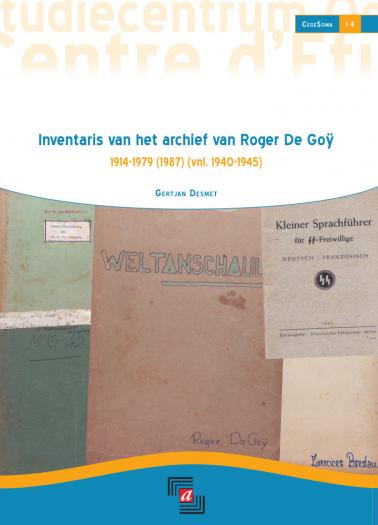New inventory!
The archives of Roger De Goÿ, officer of the Légion Wallonie

In 2022 and 2023, CegeSoma received the archives of Roger De Goÿ, one of the leaders of the rexist youth movement and an Eastern Front volunteer. The De Goÿ family donated us a total of one linear meter of archives from the period ca. 1914-1987. This interesting archive has now been made accessible: the inventory can be consulted via our search engine Agatha and is available for download. The De Goÿ archives (reference 03160) are freely accessible.
Around 1936, Roger De Goÿ (1919-1979), employed by the Grands Magasins du Bon Marché and the Banque Générale, became an active Rexist militant ( for example, within the Association de Campement et de Tourisme of count Xavier de Hemricourt de Grunne). De Goÿ eventually became federal leader of the Rexist youth movement for boys, the Serments de la Jeunesse Rexiste Masculine, and deputy to Maurice 'John' Hagemans, provost of the Jeunesse Rexiste unifiée. In March 1942, De Goÿ joined the Walloon Legion. After basic training at the Regenwurmlager in Meseritz, he left for the Eastern Front (as Hagemans' orderly), where he fought in Izjum and Majkop, among others. After the Legion's incorporation into the Waffen-SS, De Goÿ underwent officer training at the SS Junkerschule (Bad Tölz) and the SS Panzer-Grenadier-Schule (Kienschlag-Neweklau) (1943-1944). He took part in the Third Reich's last major campaigns on the Eastern Front in 1944-1945, notably around Stargard. De Goÿ ended the war as SS-Obersturmführer in the Kampfgruppe led by Henri Derriks, and was taken prisoner by the Americans in May 1945. He was sentenced to death in 1946, but his sentence was commuted and, after a reduction of his punishment, he was paroled in 1950. De Goÿ and his wife, Marie-José Germanès (1924-2022), also from a Rexist family, remained in contact with former legionnaires until their deaths.
De Goÿ's archives are particularly fascinating for the notes, manuals and teaching materials he collected during his training as an SS officer. Such items provide a detailed picture of how the Legion's cadres were trained both militarily and ideologically. De Goÿ's diaries and autobiographical writings are of obvious value, as are poetry albums containing messages from fellow prisoners at Saint-Gilles prison. His archives also contain some documents by Hagemans, especially his diary of the 18-day campaign. Finally, we should also mention some writings from the years 1950s-1970s that evoke the way in which former volunteers on the Eastern Front wrote the history of "their" Legion.